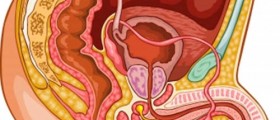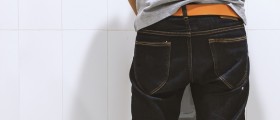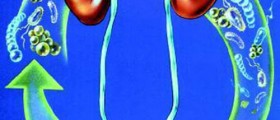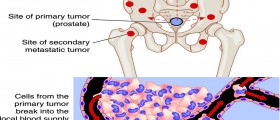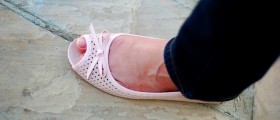The previous post had omitted the text between "Results" snd "appendix". This section of text is given below:
"RESULTS:
969 cases of HoLEP were performed at our centre between December 2003 and October 2016. There was a statistically significant improvement in both urinary flow rate and post-void residual volumes (p 80 grams, and 105 patients (10.3%) had no weight recorded.
Of the majority of the procedures performed, preoperative retention was found in 69.2% of patients with 80 grams of resected tissue as compared to 39.6% in ≤ 80 gram patients. Additionally, there was a significant amount of urethral strictures in patients with ≤ 80 grams of prostate tissue resected. Postoperative flow rates were shown to be significantly greater in both groups following HoLEP. In closing, Miss Whiting determined that HoLEP is a safe and effective procedure for LUTS in patients with small and large prostates. Furthermore, she explained that the stricture formation rate of HoLEP in this study is comparable to TURP. With the known benefits of HoLEP and its low complication rate, this procedure should be considered the gold standard for all LUTS operations.
Presented by: Danielle Whiting
Co-Authors: Guest K. , Penev B. , Cynk M.
Author Information: Maidstone and Tunbridge Wells NHS Trust, Dept. of Urology, Maidstone, United Kingdom
-----------
Loading...
Loading...
I am using the computer of the library and re-post this post. plse forgive me of posting so many times.
This post reports complications (according to the Clavien-Dindo classification) from HoLEPs, a 13 years of follow up of 1000 patients from Dec 2003 to October 2016. The presentations were given in 2017 and 2018. This is the most recent compilation of HoLEP complications in the form of modern classification. With a 1000 patients, it is stastically significant snd trustworthy.
Main results (RE and other sexual dysfunctions were not reported):
(A) Early complications: failed initial voiding trial (10.8%), stress incontinence, (6%), frequency and dysuria (5.7%), urinary tract infection (5.2);
(B) Late complications: urethral stricture(4.9%), re-operation (2.7%);
(C) For prostate of big and small sizes: "the speaker determined that HoLEP is a safe and effective procedure for LUTS in patients with small and large prostates." The functional outcomes of HoLEP is as good as TURP and open prostatectomy but with fewer complications.
When the patients were divided into prostate resected weight of 80g:
"preoperative retention was found in 69.2% of patients with 80 grams of resected tissue as compared to 39.6% in ≤ 80 gram patients. Additionally, there was a significant amount of urethral strictures in patients with ≤ 80 grams, but the stricture rate was comparable to TURP.
There are two presentations: in the first presentation prostates are not divided into size group, whereas in the second presentation, HoLEP results for prostates are divided into 80g, which lead to the conclusion that HoLEP is as good as TURP and open prostatectomy but with fewer complications.
(I) The first presentation is: PD27-05
"COMPLICATIONS OF HOLMIUM LASER ENUCLEATION OF THE PROSTATE: A SINGLE CENTRE CASE SERIES WITH 13 YEARS OF FOLLOW-UP"
By Danielle Whiting*, Thomas Smith, Branimir Penev, Mark Cynk, Maidstone, United Kingdom
Journal of Urology, May 2017
.jurology.com/article/S0022-5347(17)31450-7/pdf (free access)
(add usual header htt....ww.)
"Holmium laser enucleation of the prostate (HoLEP)... As a relatively new procedure long-term outcomes for patients undergoing HoLEP are still being studied. We describe the complications of a large single centre case series with up to 13 years of post-operative follow-up."
"RESULTS:
969 cases of HoLEP were performed at our centre between December 2003 and October 2016. There was a statistically significant improvement in both urinary flow rate and post-void residual volumes (p 80 grams, and 105 patients (10.3%) had no weight recorded.
Of the majority of the procedures performed, preoperative retention was found in 69.2% of patients with 80 grams of resected tissue as compared to 39.6% in ≤ 80 gram patients. Additionally, there was a significant amount of urethral strictures in patients with ≤ 80 grams of prostate tissue resected. Postoperative flow rates were shown to be significantly greater in both groups following HoLEP. In closing, Miss Whiting determined that HoLEP is a safe and effective procedure for LUTS in patients with small and large prostates. Furthermore, she explained that the stricture formation rate of HoLEP in this study is comparable to TURP. With the known benefits of HoLEP and its low complication rate, this procedure should be considered the gold standard for all LUTS operations.
Presented by: Danielle Whiting
Co-Authors: Guest K. , Penev B. , Cynk M.
Author Information: Maidstone and Tunbridge Wells NHS Trust, Dept. of Urology, Maidstone, United Kingdom
-----------
Appendix
Explanation of the Clavien Classification of Surgical Complications:
Grade I
Any deviation from the normal postoperative course without the need for pharmacological treatment or surgical, endoscopic and radiological interventions
Allowed therapeutic regimens are: drugs as antiemetics, antipyretics, analgetics, diuretics and electrolytes and physiotherapy. This grade also includes wound infections opened at the bedside.
Grade II
Requiring pharmacological treatment with drugs other than such allowed for grade I complications.
Blood transfusionsand total parenteral nutritionare also included.
Grade III
Requiring surgical, endoscopic or radiological intervention
- IIIa Intervention not under general anesthesia
- IIIb Intervention under general anesthesia
Grade IV
Life-threatening complication (including CNS complications)* requiring IC/ICU-management
- IVa single organ dysfunction (including dialysis)
- IVb multiorgandysfunction
Grade V Death of a patients
Loading...
sorry, it didn't work. perhaps this site has a length limit or some other problems.
Loading...
Loading...
I would say you are doing very well since you no longer leak after such a short time. As for the burning I believe others have reported that issue. Personally I never experienced that during recovery.
Who was your doctor? Did the doctor use any bladder sphincter sparing technique?
Loading...
In one of ur post, u had asked dr. Miller what was the downside of her applying the bladder neck preservation technique and she answered none.
My understanding is That technique leave a donut band of tissue near the bladder neck. That band of tissue is located at just outside of the bladder neck and provides the function of the itnernal sphincter. I believe the answer to ur question is it depends on whether the opening of that band of tissue is larger or smaller than the smallest opening of the "new (after HoLEP)" urethral channel or not. If it is larger, then it has no effect on the urine flow, if it is smaller then it will restrict the urine flow.
If urine flows thru a copper pipe, for a given pressure, the flow rate is proportional to the diameter to the fourth power of the pipe.
Not sure if u agree.
Loading...
Loading...
Loading...
What are HoLEP's advantages, complications and durability?
I worked on this post for days to bring to u an important and comprehensive review paper on HoLEP written by a HoLEP authority to answer these questions. It is for readers who are considering HoLEP as well as for those readers who already had HoLEP and want to know what to expect after their surgeries.
The paper is:
"HoLEP has come of age" by M. W. Vincent, P. J. GIlling in 2015
Department of Urology, Tauranga Hospital, Tauranga, New Zealand
This is an important paper for us to understand the advantages, complications and durability of HoLEP. The senior authors is Dr. Peter Gilling, one of the two inventors of HoLEP in 1998, who has been doing HoLEP since. He is a famous urologist. Several "highly desired" HoLEP surgeons in the US were trained by him. He has been at the forefront of technologies for BPH treatments. Recently, he is one of the two principal investigators of the multi center trial for aquablation. He knows HoLEP intimately and has special insight of HoLEP.
I modified the paper to bring out the key information. [ ] are my remarks or comments.
Main results:
1) For small, medium and large prostates, HoLEP is at least equivalent if not superior than TURP, open prostatectomy and other types of BPH surgeries;
2) For HoLEP, there is some evidence that surgery outcomes seem to be dependent on the surgeon as some seem to have achieved better results than others. The largest change for IPSS is -20 and for Qmax is +26. The smallest PVR after HoLEP is 20.7mL. [See table 1.]
3) Durability and Reoperation Rate: "Several studies have followed HoLEP patients to determine long-term outcomes, the three longest reported series include follow-up for between 5 and 10 years.
All of the studies show that the [excellent] urodynamic outcomes persist over time [period studied which is 5-10 years], Re-operation rate for residual adenoma is very low, below 1 %. This is in contrast to TURP where the reoperation rate is around 7.4 % [14] and PVP with a reoperation rate in the region of 5.6 % [15]." [See table 2.]
4) Complications:
perioperative : capsular perforation is rare, blood transfusion is about 0.4%, bladder injury is 0.7 and urinary transient incontinence is 0.1%, infection is below 5 % with very low rates of sepsis;
Postoperative: [persistent incontinence (SUI+UUI) could be as high as 17%] "in the initial post-operative period, but ...after 3 months have each dropped to levels around 2 %. After 12 months, the rate of persistent SUI is 0.5 % and UUI 1 % [17]"; reoperation rate is less than 1%; "[urethra] Strictures and bladder neck contractures rate [is 2.6%] seem to occur at a similar rate to other transurethral procedures"; "Failed to void, These include failed trial of void (TOV)," is about 1.7%,
5) Operative, catheter and hospital time: "HoLEP does require a longer operative time in smaller glands partly due to the need to morcellate after the enucleation. The volume of resected tissue for a given sized gland, however, is signifcantly greater for HoLEP, making the overall efficiency of the procedure much more comparable. Ahyai et al. [19] performed a matched analysis comparing HoLEP with TURP and open enucleation. They found that for small/medium prostates, HoLEP operative time was comparable to TURP where similar masses were resected. As volumes increased, HoLEP became signifcantly more efficient and rivalled open prostatectomy for pure speed until the prostates became very large.
Table 3 demonstrates the reduced hospital stay and catheterization times that can be achieved with HoLEP as compared to other techniques. Not only is a reduced catheterization time good for patient comfort, it also allows for earlier patient discharge. Hospital stays are signifcantly reduced when HoLEP is utilized, which can translate to cost savings and increased hospital efficiency."
I -- General and Useful Information
Why HoLEP? Why always compare HoLEP to TURP and open prostatectomy?
"Various management strategies have been employed for the management of lower LUTS since the ancient Egyptians in the fifteenth century BC but over the last century, the transurethral resection of the prostate (TURP) has been considered the standard of care." Likewise, for large
prostrates (80cc), before HoLEP, open prostatectomy was the only choice and for smaller prostrates (800 g!
How well can HoLEP relieve BHP symptoms compared with TURP and open
prostatectomy (see table 1)?
"The basis is the efficacy of TURP and open prostatectomy for improving symptoms has never been in question", as they have been the standard care for decades with very good results." Thus all one needs to prove is "HoLEP to be at least equivalent if not superior" than the former two in terms of outcomes, complications and durability.
"The TURP remains the benchmark reference standard against which all new techniques are measured. Many new variations and novel techniques have come and gone, but the holmium laser enucleation of the prostate (HoLEP) has stood the test of time and gives equal or better outcomes when compared to standard TURP. "
"....various improvements in (HoLEP) technique have been developed and numerous trials have demonstrated not only its efficacy and durability, but also its safety. There are numerous published studies from all around the world looking at various aspects of HoLEP. The
majority of the RCTs have small numbers; however, the outcomes are universally similar and confrmed in well-conducted meta-analyses giving reasonable level 1 evidence."
How much experience should a HoLEP surgeon have?
"In published studies specifcally looking at the learning curve for HoLEP, both enucleation and morcellation efficiency plateaued after approximately 20–30 cases [28, 31]. There seems to be an increased complication rate associated with the initial cases in a self-taught learning curve that decreases rapidly as experience is gained. With an appropriately set up mentoring system, there does not seem to be an associated increase in complication rate, only a slower enucleation rate [32]."
[Note: longer operating time by inexperienced surgeons can cause more complications as the tissues are subjected to longer stress.]
II -- How Effective Is HoLEP?
Table 1 Comparison of HoLEP efficacy
Format: Investigator, Technique used, No of patients/Age (N/A), prostateSize (g)/weight-removed(g)(S/W), Change in IPSS/Change in Qmax(I/Q)
RCT=random controlled trial, open= open prostectomy, bipolar =bipolar TURP, greenlight=grenlight laser PVP, PKRP=plasmakinetic resection of prostate.
-- N/A S/W I/Q
Tan [6] (RCT):
HoLEP 30/71.7 77.8/40.4 −20.0/18.0
TURP 30/70.3 70.0/24.7 −18.9/12.5
Kuntz [7] (RCT):
HoLEP 100/ 68 53.5/32.6 −19.9/20.2
TURP 100/68.7 49.9/37.2 −17.7/21.8
Rigatti [8] (RCT):
HoLEP 5/ 65.1 60.3/-- −17.7 14.9
TURP 48/64.5 56.2/-- −19/18.7
Shishido [9] (Cohort):
HoLEP 46/68.2 74.5/34.8 −12.1/14
TURP 41/69.2 77.7/29.3 −13.4/10.4
Kuntz [10] (RCT):
HoLEP 60/69.2 114.6/93.7 −19.7/26.1
Open 60/71.2 113/96.4 −18.2/23.4
Fayad [11] (RCT):
HoLEP 30/60.0 76.5/55.9 −17.1/13.4
Bipolar 30/61.2 80.6 /65.6 −16.8/13.6
Elmansy [12] (RCT):
HoLEP 43/71.5 91.3/-- −18/20
Greenlight 37/73.2 89.3/-- −18.5/13.6
Chen [13] (RCT):
HoLEP 140/72.1 56.7/48.5 −15.4/16.0
PKRP 140/73.5 60.3/41.1 −15.2/15.81
[Note: for HoLEP, I/Q seems to be dependent on the surgeon. Some has better results than others. The largest change for IPSS is -20 and for Qmax is +26.]
"Table 1 shows a selection of publications comparing HoLEP with alternative treatments; although not an exhaustive list, it covers a broad cross section of available studies. It can be seen that HoLEP consistently outperforms other modalities including the reference 'gold standard’ TURP. A Meta-analysis [5] confirmed the published randomized controlled trial (RCT) outcomes showing HoLEP to be equivalent to TURP with a trend towards statistically significant
overall superiority. As the efficacy of TURP and open prostatectomy for improving symptoms has never been in question, finding HoLEP to be at least equivalent if not superior demonstrates its efficacy as a viable treatment for LUTS....."
III -- HoLEP's Durability
"Several studies have followed HoLEP patients to determine long-term outcomes, the three longest reported series include follow-up for between 5 and 10 years.
All of the studies show that the urodynamic outcomes persist over time, Reoperation rate for residual adenoma is very low, below 1 %. This is in contrast to TURP where the reoperation rate is around 7.4 % [14] and PVP with a reoperation rate in the region of 5.6 % [15]. [Urethra] Strictures and bladder neck contractures seem to occur at a similar rate to other transurethral procedures."
Table 2 Long-term follow-up
Format: investigators, followup FU (year) Symptom score(S), Qmax (ml/s)/PVR (ml)(Q/P), Urethral-Stricture (%)/Reoperation for BPH (%)(US/RO)
-- FU S Q/P US/RO
Krambeck [16]
1st FU 8.7 17.9/--
Last FU ≥5a 5.1 22.7/-- 2.6 %/0.1 %
Elmansy [17]
1st F/U 7 22/48
Last FU 9–10b 3.6 26.9/20.7 2.4 %/0.7 %
Gilling [18]
1st F/U 8.6 22.3/--
Last FU 5.9-10 8.0 22.09/-- --/ 0 %
[Note: this table demonstrates 10 years of durability. Also [Urethra] Strictures and bladder neck contractures are issues but seem to occur at a similar rate to other transurethral procedures." Not sure what symptom score is. ]
a Mean follow-up for entire cohort was 287 days, and the results shown are for the 7.8 % (83 patients out of 1,065) who reached more than 5-year follow-up mean 7 years
b Mean follow-up for entire cohort was 62 months; however, the results for the 250 patients (out of 949 total) reaching 9–10 years recorded here
"Table 2 shows the persistent improvements seen in the maximum flow (Qmax) and symptom score from the first follow-up to [the] most recent, which in these three papers are over 5 years and up to 10 years. Over time, the scores seem to improve; however, these patients represent a small subset of the original cohort.
Volume resected vs Operative, hospital and catheter time
Table 3 Operative and post-operative comparisons
Format: Operative time (min)/Volume resected (g)(OT/VR), Catheter time(h)/Hospital stay (h)(C/H)
Gilling [18] OT/VR C/H
HoLEP 62.1/40.4 17.7/27.6
TURP 33.1/24.7 44.9/49.9
Kuntz [7]
HoLEP 94.6/32.6 26.7/53.3
TURP 73.8/37.2 43.4/85.8
Kuntz [25]
HoLEP 135.9/93.7 30.8/70
Open 90.6/96.4 194.4/250
Elmansy [12]
HoLEP 107/-- 28.8/ --
PVP 110/-- 33.6/--
"HoLEP does require a longer operative time in smaller glands partly due to the need to morcellate after the enucleation. The volume of resected tissue for a given sized gland, however, is signifcantly greater for HoLEP, making the overall efficiency of the procedure much more comparable. Ahyai et al. [19] performed a matched analysis comparing HoLEP with TURP and open enucleation. They found that for small/medium prostates, HoLEP operative time was comparable to TURP where similar masses were resected. As volumes increased, HoLEP became signifcantly more efficient and rivalled open prostatectomy for pure speed until the prostates became very large.
Table 3 demonstrates the reduced hospital stay and catheterization times that can be achieved with HoLEP as compared to other techniques. Not only is a reduced catheterization time good for patient comfort, it also allows for earlier patient discharge. Hospital stays are signifcantly reduced when HoLEP is utilized, which can translate to cost savings and increased hospital efficiency."
IV -- HoLEP's Complications
"Complications of HoLEP are similar to other techniques, but they tend to occur at lower rates compared with other treatment modalities."
IV-1 Peri-operation Complications
Table 4 Perioperative complication
Format: No. of pts(N), . Capsular perforation (%)(CP), Transfusion (%)(T)
Bladder injury (%)(BI), UTI (%)
-- N CP T BI UTI
Elzayat [28] 118 --- 1.7 0.8 1.7
Placer [29] 125 10.4 0.8 4 2.4
Krambeck [16] 1,065 --- ---- 0.1a 0.1b
Elmansy [17] 949 --- 0.4 0.7 ---
a= (excluding superficial), b=(sepsis only)
[Note: Placer learned HoLEP by himself without a mentor. Thus his patients have higher rate of complications. The results from the two largest studies by Kramneck and Elmsnsy are more representative .]
1) Capsular perforations
"Capsular perforations occur in HoLEP just as frequently as in TURP. However, due to the use of saline as the irrigation fluid, absorption is much less of an issue as compared to the use of glycine as for TURP. Fluid absorption has also been shown to be significantly lower when compared to TURP, 0–300 versus 300– 900 ml, respectively [26]. There have been no reported cases of TUR Syndrome following HoLEP in the reported literature."
2) Transfusion
"Transfusion rates are uniformly low, and it has been shown to be possible to perform HoLEP safely on patients with ongoing anticoagulation [27]. In general, we try to stop anticoagulants if
possible or at least convert them to bridging low molecular weight heparin if the risk of stopping it is too high. The same is true of the anti-platelet agents such as Clopidogrel, where, if possible, we wait until the medication can be withheld safely before performing the operation and we do not routinely stop aspirin prior to HoLEP. In the vast majority of cases, surgery is being utilized in an elective manner, and as such, unnecessary risks should not be undertaken, even if relative safety has been reported for a specific technique."
3) Bladder injury
"Bladder injury is a complication more specifically associated with HoLEP due to the use of the mechanical morcellator, and the majority of these injuries are superficial and require no change in management; however, there exists a risk of severe full thickness injury [not sure what it is ??] although this is exceeding rare as can be seen in Table 4."
4) Infections
"Infections also appear to be reported less frequently after HoLEP, and their risk is uniformly below 5 % with very low rates of sepsis. The majority of centres appear to utilize a similar antibiotic prophylaxis regime as for TURP and given the low incidence of infections, there is
no evidence that a different regime is required."
IV-2 Post-operation Complications
Table 5 Post-operative complications
Format: No. of pts(N), . Failed TOV (%)(FTV), Persistent incontinence (SUI
and UUI) (3 months) (%)(PI), Reoperation (%)(RO), Stricture/bladder neck
contracture (%)(S-BNC)
-- N. FTV PI RO S-BNC
Placer [29] 125 4 4.8 0.8 5.6
Krambeck [16] 1,065 --- 4.8 0.1 2.6
Elzayat [28] 118 1.7 2.5 4.2a 1.47
Elmansy [17] 949 --- 1.5 0.7 2.4
a=(1.5 for late group)
In the postoperative setting, immediate and delayed complications are again similar for HoLEP as compared to other modalities.
1) Failed to void
These include failed trial of void (TOV) and is about 1.7%,
2) Incontinence
The most significant issue related to HoLEP is that of incontinence, and this can be equally split into urge urinary incontinence (UUI) and stress urinary incontinence (SUI). Both of these occur occasionally in the initial post-operative period, but uniformly decrease during follow-up, and after 3 months have each dropped to levels around 2 %. After 12 months, the rate of persistent SUI is 0.5 % and UUI 1 % [17].
3) Strictures/bladder neck contractures
"[Urethra] Strictures and bladder neck contractures seem to occur at a similar rate to other transurethral procedures."
4) Reoperation
Reoperation, due to ongoing or recurrent symptoms attributable to BPH, is less than a percent except the Elzayat study which is 4.2% initially then dropped to 1.5% later.
5) [Retrograde Ejaculation is not mentioned. The chance of RE is 70-80%].
Table 5 summarizes some of these delayed complications as reported in
the literature.
"The majority of the initial issues are due to irritation from the resection, leading to, often severe, urgency, frequency [of urination] and dysuria. We find it useful to thoroughly counsel the patients
about this issue preoperatively and provide reassurance that it will gradually settle over the first few postoperative months [as the irritation subsides]. This helps to reduce anxiety if it does develop and avoids unnecessary early follow-ups.
Overall complications related to HoLEP are significantly lower and in general [and] less severe in nature when compared to TURP, open surgery and the majority of its minimally invasive competitors."
Loading...
This post reports complications (according to the Clavien-Dindo classification) from HoLEPs, a 13 years of follow up of 1000 patients from Dec 2003 to October 2016. The presentations were given in 2017 and 2018. This is the most recent compilation of HoLEP complications in the form of modern classification. With a 1000 patients, it is stastically significant snd trustworthy.
Main results (RE and other sexual dysfunctions were not reported):
(A) Early complications: failed initial voiding trial (10.8%), stress incontinence, (6%), frequency and dysuria (5.7%), urinary tract infection (5.2);
(B) Late complications: urethral stricture(4.9%), re-operation (2.7%);
(C) For prostate of big and small sizes: "the speaker determined that HoLEP is a safe and effective procedure for LUTS in patients with small and large prostates." The functional outcomes of HoLEP is as good as TURP and open prostatectomy but with fewer complications.
When the patients were divided into prostate resected weight of 80g:
"preoperative retention was found in 69.2% of patients with 80 grams of resected tissue as compared to 39.6% in ≤ 80 gram patients. Additionally, there was a significant amount of urethral strictures in patients with ≤ 80 grams, but the stricture rate was comparable to TURP.
There are two presentations: in the first presentation prostates are not divided into size group, whereas in the second presentation, HoLEP results for prostates are divided into 80g, which lead to the conclusion that HoLEP is as good as TURP and open prostatectomy but with fewer complications.
(I) The first presentation is: PD27-05
"COMPLICATIONS OF HOLMIUM LASER ENUCLEATION OF THE PROSTATE: A SINGLE CENTRE CASE SERIES WITH 13 YEARS OF FOLLOW-UP"
By Danielle Whiting*, Thomas Smith, Branimir Penev, Mark Cynk, Maidstone, United Kingdom
Journal of Urology, May 2017
jurology.com/article/S0022-5347(17)31450-7/pdf
(Free access, add to the above link the usual header htt....ww.)
"Holmium laser enucleation of the prostate (HoLEP)... As a relatively new procedure long-term outcomes for patients undergoing HoLEP are still being studied. We describe the complications of a large single centre case series with up to 13 years of post-operative follow-up."
"RESULTS:
969 cases of HoLEP were performed at our centre between December 2003 and October 2016. There was a statistically significant improvement in both urinary flow rate and post-void residual volumes (p 80 grams, and 105 patients (10.3%) had no weight recorded.
Of the majority of the procedures performed, preoperative retention was found in 69.2% of patients with 80 grams of resected tissue as compared to 39.6% in ≤ 80 gram patients. Additionally, there was a significant amount of urethral strictures in patients with ≤ 80 grams of prostate tissue resected. Postoperative flow rates were shown to be significantly greater in both groups following HoLEP. In closing, Miss Whiting determined that HoLEP is a safe and effective procedure for LUTS in patients with small and large prostates. Furthermore, she explained that the stricture formation rate of HoLEP in this study is comparable to TURP. With the known benefits of HoLEP and its low complication rate, this procedure should be considered the gold standard for all LUTS operations.
Presented by: Danielle Whiting, Co-Authors: Guest K. , Penev B. , Cynk M.
Author Information: Maidstone and Tunbridge Wells NHS Trust, Dept. of Urology, Maidstone, United Kingdom
-----------
Appendix
Explanation of the Clavien Classification of Surgical Complications:
Grade I
Any deviation from the normal postoperative course without the need for pharmacological treatment or surgical, endoscopic and radiological interventions
Allowed therapeutic regimens are: drugs as antiemetics, antipyretics, analgetics, diuretics and electrolytes and physiotherapy. This grade also includes wound infections opened at the bedside.
Grade II
Requiring pharmacological treatment with drugs other than such allowed for grade I complications.
Blood transfusionsand total parenteral nutritionare also included.
Grade III
Requiring surgical, endoscopic or radiological intervention
- IIIa Intervention not under general anesthesia
- IIIb Intervention under general anesthesia
Grade IV
Life-threatening complication (including CNS complications)* requiring IC/ICU-management
- IVa single organ dysfunction (including dialysis)
- IVb multiorgandysfunction
Grade V Death of a patients
Loading...
Post 1:
"RESULTS:
969 cases of HoLEP were performed at our centre between December 2003 and October 2016. There was a statistically significant improvement in both urinary flow rate and post-void residual volumes (p
Loading...
Sorry, try again. Below are the missing texts.
"RESULTS:
969 cases of HoLEP were performed at our centre between December 2003 and October 2016. There was a statistically significant improvement in both urinary flow rate and post-void residual volumes. Median pre-operative flow rate was 8.4ml/s. and post-operative flow rate was 19.5ml/s. Median pre-operative post-void residual volumes were 263mls and post-operative residual volumes were 71mls .188 patients (23.6%) were discharged from hospital on the day of surgery; 479 (60.1%) on day 1; 85 (10.7%) on day 2; 45 (5.6%) stayed 3 days or more. Post-operative early and late complications are recorded within the table."
[in the table, what is early and what is late are not defined. My guess is early means within a month and late is after a month.]
Table of complications (see appendix for Clavien-Dindo classification of complications)
969 patients
Format: type of complication , number of patients (%)
"(A) Early Complications
Clavien grade 1:
Failed initial voiding trial 105 (10.8)
Transient stress incontinence 58(6.0)
Frequency and dysuria 55 (5.7)
Post-operative confusion 3 (0.3)
[RE is not reported.]
Clavien grade 2:
Urinary tract infection 50(5.2)
Secondary haemorrhage 12(1.2)
Epididymitis 7(0.7)
Blood transfusion 4 (0.4)
Nausea and vomiting 2 (0.2)
Chest infection 1(0.1)
Chest pain = 1(0.1)
Supra ventricular tachycardia 1(0.1)
Clavier grade 3b:
Return to theatre 14(1.4)
Ureteric obstruction 2(0.2)
Conversion to TURP 2(0.2)
Clavien grade 4a:
Urinary sepsis 1(0.1)
Clavien grade 5:
MI and cardiac arrest 1(0.1)
(B) Late Complications
Clavien grade 2:
Rectoprostatic fistula 1(0.1)
Clavien grade 3a:
Submeatal stenosis 3(0.3)
Clavien grade 3b
Urethral stricture 47(4.9)
Redo TURP or HOLEP 27(2.8)
Bladder neck stenosis 13(1.3)"
-------------------
(II) The second presentation is:
(HOME CONFERENCE HIGHLIGHTS EAU 2018: )
HOLMIUM LASER ENUCLEATION OF THE PROSTATE IS EFFECTIVE AND SAFE IN ALL PROSTATE SIZES
urotoday.com/conference-highlights/eau-2018/eau-2018-prostate-cancer/102774-eau-2018-holmium-laser-enucleation-of-the-prostate-is-effective-and-safe-in-all-prostate-sizes.html
(Free access, add to the above link the usual header htt....ww.)
A retrospective analysis of a prospective database from a single center was used to extract patient data of those who were underwent HoLEP procedures for the treatment of LUTS between December 2003 to March 2017. The data was divided according to the weight of prostatic tissue collected following surgical ablation; this data was divided into two groups: above 80 grams and up to 80 grams. Upon completion of the database analysis, 1016 cases of HoLEP was determined to have occurred at the center. 841 patients (82.8%) had a prostatic resected weight ≤ 80 grams, 70 patients (10.3%) had prostatic weight 80 grams, and 105 patients (10.3%) had no weight recorded.
Of the majority of the procedures performed, preoperative retention was found in 69.2% of patients with 80 grams of resected tissue as compared to 39.6% in ≤ 80 gram patients. Additionally, there was a significant amount of urethral strictures in patients with ≤ 80 grams of prostate tissue resected. Postoperative flow rates were shown to be significantly greater in both groups following HoLEP. In closing, Miss Whiting determined that HoLEP is a safe and effective procedure for LUTS in patients with small and large prostates. Furthermore, she explained that the stricture formation rate of HoLEP in this study is comparable to TURP. With the known benefits of HoLEP and its low complication rate, this procedure should be considered the gold standard for all LUTS operations.
Loading...





